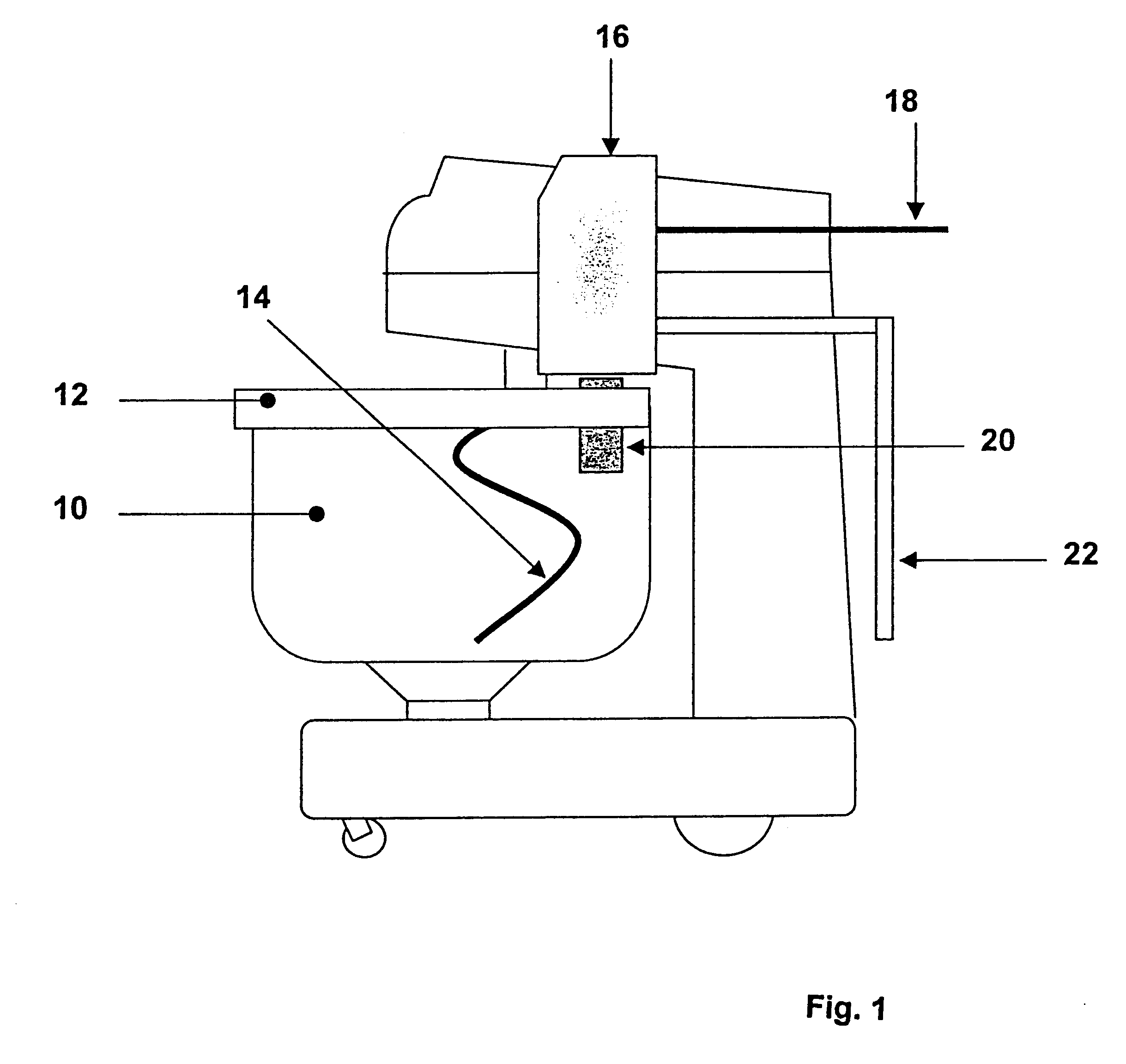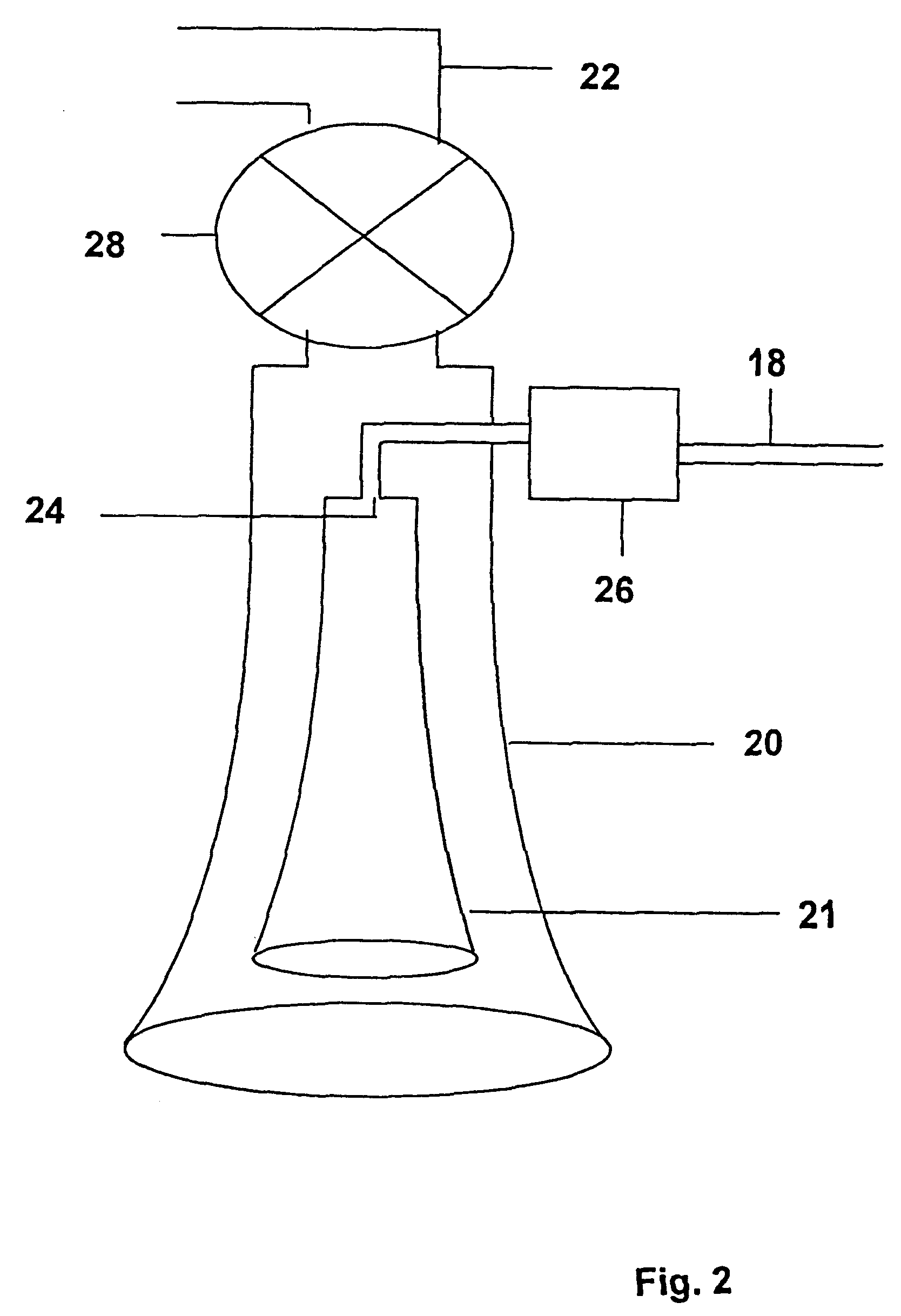The invention is thus based on the object of developing the known apparatus to the effect that already existing devices can be easily retrofitted with a dough or, respectively, container cooling.
Beneficially, the snow tube is widened at the CO.sub.2 snow delivery side. A more uniform output of the CO.sub.2 snow into the container is thus assured.
The invention is based on the surprising
perception that the concentric arrangement of the snow tube and the surrounding outer tube of the separating means results merely in a
double tube and, thus, a structural intervention for passing the
double tube through need only be undertaken at one location of the container cover for
retrofitting existing devices with the dough or container cooling. Over and above this, the snow tube that is shorter compared to the outer tube enables an extraction of the CO.sub.2 not converted into CO.sub.2 snow before the CO.sub.2 gas enters into the container at all, which enables a better monitoring and setting of the
partial oxygen pressure in the head space of the container and, further, prevents a displacement of the
oxygen as well as an introduction of the CO.sub.2 gas into the product located in the container as well as contact therewith. Due to the
cyclone effect, moreover, the inventive apparatus exhibits an extremely high CO.sub.2 snow generating efficiency that nearly corresponds to the theoretical efficiency of 60%. The CO.sub.2 gas extraction means, in combination with the outer tube, can also be employed after the CO.sub.2 snow injection phase to extract the CO.sub.2 gas subsequently formed with the CO.sub.2 snow. The inventive apparatus thus enables an especially good cooling of the reaction processes with the cold content of the CO.sub.2 snow without the product to be cooled coming into contact with the CO.sub.2 gas to any noteworthy extent and being thus damages.
3. Fruit and
vegetable processing: peeled apples or peeled potatoes but also salads (iceberg salad, etc.) can be preserved by water emersion baths (low-pressure container) specifically saturated with the CO.sub.2 snow. As a result thereof, an employment of preservatives (sulfites, etc.) can be avoided. The objective is, on the one hand, to introduce .gtoreq.7.0 g CO.sub.2 / kg water and, on the other hand, to
exploit the
cooling effect. The high CO.sub.2 concentration enables both anti-microbial effects (reduction in the number of germs) as well as the minimization of enzymatic processes ("enzymatic
browning" due to phenoloxidases) due to O.sub.2 displacement, and the like. The necessary CO.sub.2 concentration given simultaneous
cooling effect can be achieved by
dry ice (CO.sub.2 snow). The extraction of the CO.sub.2 gas is therefore also required for this process.
4. Grain mashes: in a malt house, grain is caused to germinate in
germination boxes or the like at high water contents and elevated temperature (approximately 5 through 7 days). Cooling these mashes down to further-
processing or, respectively, storing temperature dare not change the
water content of the mashes and should be as fast as possible (due to the microbial risks) but without any CO.sub.2 gas (in order to avoid anaerobic processes for avoiding disadvantageous solubilization or extraction processes as well that occur due to the CO.sub.2 gas in solution). In a similar application, what are referred to as "brew batches" (cooked grain) in a bakery can be very rapidly cooled to further-
processing or, respectively, storing temperature without changing the dough yield (
water content) and without introduction of the CO.sub.2 gas.
The inventive apparatus can also be of great assistance in maintaining the cooling chain when transporting food stuffs and other sensitive materials. With the assistance of non-stationary apparatus, for example, a suitable insulating container can be very easily "snowed" with the CO.sub.2 snow. When this is carried out at the upper part of the container, a uniform distribution of the snow from top to bottom occurs, and this causes a very uniform distribution on the repackaged food stuffs (cartons, etc.). As a result thereof, the desired transport or intermediate storing temperature of, for example, 18.degree. C. can be maintained over a long time (for example eight hours). Here, too, the active removal of the CO.sub.2 gas arising "in statu nasceni" is necessary in order to assure adequate worker protection and working security (the enrichment of CO.sub.2 gas in the environment is intolerable for reasons of worker safety). When unpackaged food stuffs are to be cooled and transported in the insulated container (for example, open cream products, bakery products with unbaked filling,
baked goods, sausages, etc.), then snowing with
dry ice can ensue. CO.sub.2 gas (water as well) is to be avoided here, first in order to prevent a quality change of the product (taste, color etc.) and, on the other hand, in order to adhere to work protection and
work safety.
 Login to View More
Login to View More  Login to View More
Login to View More 


